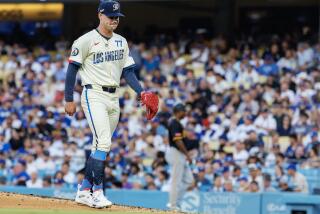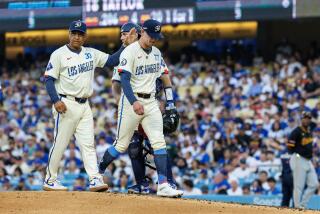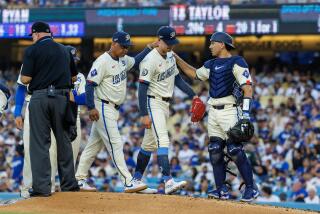Baseball ’89 : A Preview : Rangers Gained Not Only Ryan, but 21 Years’ Experience
PORT CHARLOTTE, Fla. — A freak of nature? Not at all. Nolan Ryan is no different from any other pitcher who, at 42, throws 95-m.p.h. fastballs.
By all standards, Ryan should have lost his blazer years ago. But here he is, ready for his 22nd major league season as a newcomer to the Texas Rangers, and he has no idea when he might retire. After all, who quits when he is ahead?
“I’ve had people call me a freak for several years,” Ryan said at the Rangers’ training complex. “But it wouldn’t be my choice of words. I like the term unusual, or out of the norm. What they’re saying is, yes, I’m not exactly ordinary.”
Making Ryan’s longevity doubly remarkable is that he has twice overcome serious elbow ailments. He had surgery for bone chips in 1975 and for a torn tendon in 1986.
Ryan offers no explanation for his success.
“I’m as surprised as anybody else,” he said. “When you try to project longevity, there’s no scientific way. All the other power pitchers I’ve known lost their velocity in their mid-’30s or late ‘30s.”
Of course, Ryan has done more than just hang around since he broke into the major leagues with the New York Mets in 1968. He has pitched a record five no-hit games; he is the all-time strikeout leader with 4,775 strike outs in 4,547 innings. He also holds 39 other major league records.
As great as he has been, though, Ryan was anything but an overnight success. If he had been, the Mets, who had picked him in the 10th round of the inaugural amateur draft in 1965, might never have traded him.
After four seasons in which Ryan suffered from severe wildness and won only 29 games, the Mets traded him to the Angels, along with pitcher Don Rose, catcher Francisco Estrada and outfielder Leroy Stanton for infielder Jim Fregosi.
Ryan then found his form. In his first year with the Angels, he won 19 games, had a 2.28 earned-run average and won the first of his nine strikeout titles.
“I was so frustrated with the Mets that I wanted to quit,” Ryan recounted. “I just couldn’t get my breaking pitch over. I’d been in their organization seven years, and I wasn’t making any progress.”
Ryan played a small role in the 1969 Miracle Mets who won the World Series. He started only 10 games and worked only 89 innings.
How did Ryan overcome his control problem?
“It was just a matter of pitching a lot of innings,” he said. “People say, ‘That guy’s a thrower. He’s got to learn how to pitch.’ That’s a fallacy. Until you get control, you can’t be a pitcher.
“Fifteen to 18 years ago, I had a reasonable idea how to pitch, but I kept getting behind in the count. There wasn’t any (one) point in my career when I had a turnaround. It was a gradual process.”
Ryan’s sudden emergence suggests otherwise, but a look at the bases-on-balls column bears him out. He led the American League in walks six times in his first seven years as an Angel, reaching a career high of 204 in 299 innings in 1977.
He also needed complimentary pitches. Ryan’s curveball is vastly underrated, and his changeup isn’t bad, either.
“It took me four or five years to develop a curveball,” he said. “I didn’t develop a changeup until the last eight or 10 years.”
Ryan’s fastball, however, is not as fast as it ever was.
“My fastest reading ever was 100 (m.p.h.), when I was with the (Houston) Astros,” he said. “That happened when I was 38 years old, but I’m not that fast on a consistent basis now. The radar gun didn’t come in until the late ‘70s, so I don’t know how hard I threw when I was young.
“In high school (in Alvin, Tex.,), I was probably one of the hardest throwers who ever went through Texas baseball. The kids were intimidated, scared. They didn’t want to get hurt. This was especially true in night games, because the lights were so bad.
“We didn’t have good lights in the minor leagues, either, but at least there were a few good hitting prospects. A lot of high school teams didn’t even have any college prospects.”
Ryan spent the last nine seasons with the Astros, only 25 miles from his cattle ranch at Alvin, but left as a free agent and signed with the Rangers.
“I felt that the Rangers were putting together a competitive ballclub,” he said. “I thought the Astros weren’t doing enough to improve their club.”
Ryan also was given a better contract by Texas. He made $1.3 million last season, and the Astros wanted to cut him to $800,000 or $900,000. The Rangers gave him $1.6 million for this year, plus a $200,000 signing bonus, and $1.4 million for next year with a provision for a $200,000 buyout.
Two of Ryan’s five no-hitters, one more than pitched by Sandy Koufax, have given him especially fond memories.
“The second one was my best,” Ryan said. “I was more overpowering in that game than ever before or since. The fifth one was the most meaningful, because I was going for the record after being tied with Koufax.”
Amazingly, Ryan also has pitched nine one-hitters, including one last year in which Mike Schmidt of the Philadelphia Phillies ruined his bid for a sixth no-hitter with one out in the ninth inning.
Asked if any hitter had been particularly tough, Ryan said, “I’ve faced a lot of power guys, but I had as much trouble with a .200 hitter, Mark Belanger. He would bunt, or beat out a bleeder to the infield. He even broke up a no-hitter one time in the eighth inning.”
The only rap against Ryan over the years has been his record, which is 273-253. He has been called a .500 pitcher.
“I hear that all the time,” he said. “A lot of times, I give up a run and it costs me a game. Also, I never pitched for clubs that scored a lot of runs.”
Because he is no longer a consistent nine-inning pitcher, Ryan was asked if he was concerned about the Rangers’ lack of an established ace relief pitcher.
“No, I thought about what happened to (former Dodger and Angel) Don Sutton,” Ryan said. “He wanted to go to Milwaukee because they had Rollie Fingers, and as soon as he got there, Fingers blew out his arm.”
Ryan’s favorite ballparks? Dodger Stadium isn’t one of them.
“I enjoy Wrigley Field in Chicago,” he said. “It has a lot of charisma when the ivy is all leafed out, a lot of nostalgia. Anaheim Stadium was about as pretty as any until they closed it in.
“Dodger Stadium is pretty, but I don’t like it. It’s right in the middle of L.A., plus it’s got smog, traffic and Tom Lasorda. We always had trouble winning there, too, so it could be circumstances more than anything else.”
Ryan recalled that he thought he was signing his last contract when he agreed to a three-year deal with the Astros in 1979.
“I was 32 at the time, and I didn’t see myself pitching beyond 34,” he said.
Ten years later, Ryan remains one of the most overpowering starting pitchers in baseball.
More to Read
Go beyond the scoreboard
Get the latest on L.A.'s teams in the daily Sports Report newsletter.
You may occasionally receive promotional content from the Los Angeles Times.






